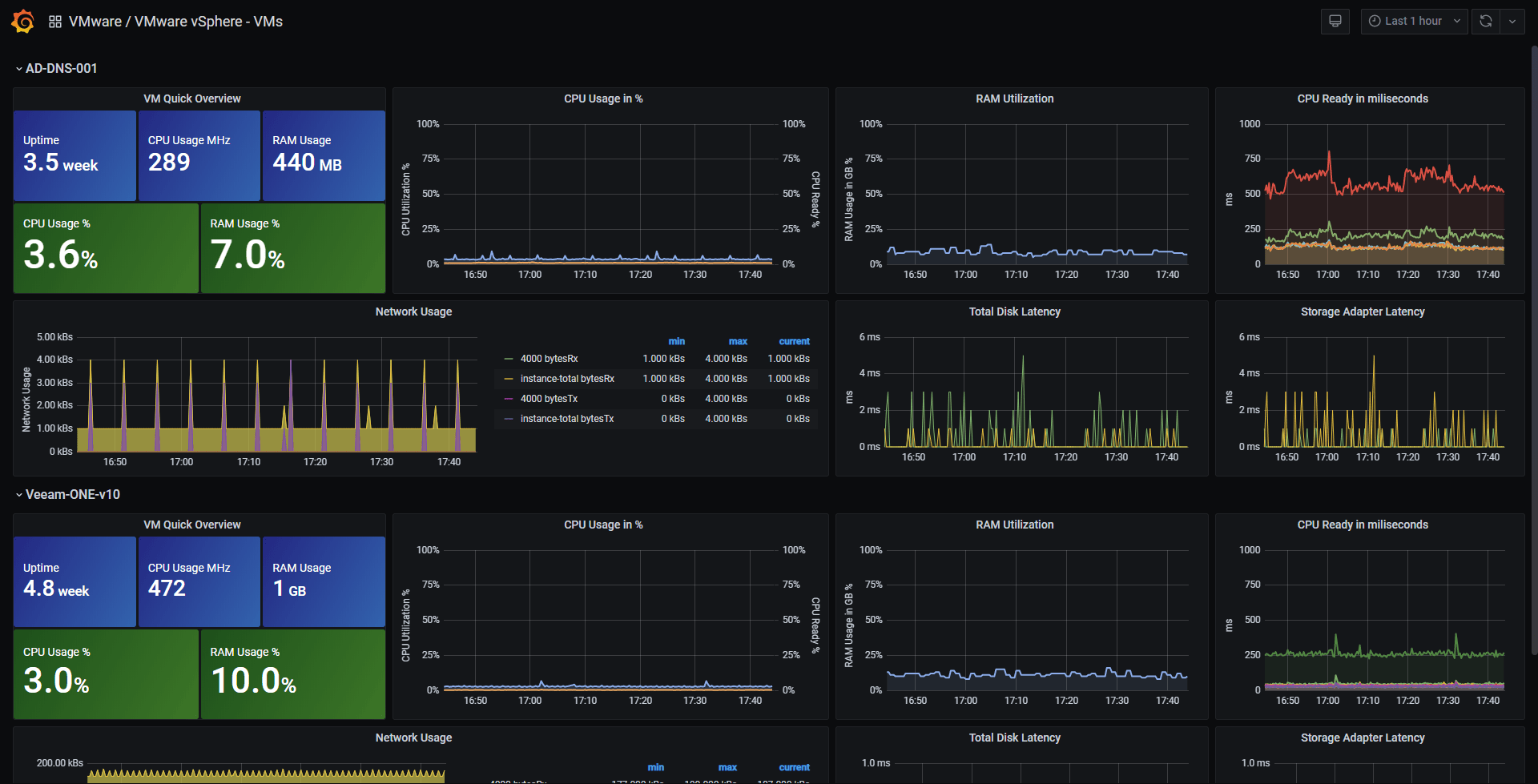2018-10-23T12:19:47Z I! Starting Telegraf 1.8.1
2018-10-23T12:19:47Z I! Loaded inputs: inputs.vsphere
2018-10-23T12:19:47Z I! Loaded aggregators:
2018-10-23T12:19:47Z I! Loaded processors:
2018-10-23T12:19:47Z I! Loaded outputs: influxdb
2018-10-23T12:19:47Z I! Tags enabled: host=17e81504ea04
2018-10-23T12:19:47Z I! Agent Config: Interval:10s, Quiet:false, Hostname:"17e81504ea04", Flush Interval:10s
2018-10-23T12:19:50Z E! [input.vsphere]: Error while getting metric metadata. Discovery will be incomplete. Error: ServerFaultCode: A specified parameter was not correct: entity
2018-10-23T12:19:50Z E! [input.vsphere]: Error while getting metric metadata. Discovery will be incomplete. Error: ServerFaultCode: A specified parameter was not correct: entity
2018-10-23T12:19:50Z E! [input.vsphere]: Error while getting metric metadata. Discovery will be incomplete. Error: ServerFaultCode: A specified parameter was not correct: entity
2018-10-23T12:19:50Z E! [input.vsphere]: Error while getting metric metadata. Discovery will be incomplete. Error: ServerFaultCode: A specified parameter was not correct: entity
2018-10-23T12:19:50Z E! [input.vsphere]: Error while getting metric metadata. Discovery will be incomplete. Error: ServerFaultCode: A specified parameter was not correct: entity
2018-10-23T12:19:50Z E! [input.vsphere]: Error while getting metric metadata. Discovery will be incomplete. Error: ServerFaultCode: A specified parameter was not correct: entity
The database has information about VM names e.al. but no performance metrics.
Could you support with an idea of where things are going wrong?
[[outputs.influxdb]]
urls = ["http://192.168.10.14:8086"] # required
database = "mumindalen_esxi" # required
## Write timeout (for the InfluxDB client), formatted as a string.
## If not provided, will default to 5s. 0s means no timeout (not recommended).
timeout = "10s"
username = "username"
password = "password"
## Set the user agent for HTTP POSTs (can be useful for log differentiation)
# user_agent = "telegraf"
## Set UDP payload size, defaults to InfluxDB UDP Client default (512 bytes)
# udp_payload = 512
# Read metrics from one or many vCenters
[[inputs.vsphere]]
## List of vCenter URLs to be monitored. These three lines must be uncommented
## and edited for the plugin to work.
vcenters = [ "https://mylocalIP/sdk" ]
username = "" #Uing my normal password here (for webUI)
password = "password"
## VMs
## Typical VM metrics (if omitted or empty, all metrics are collected)
vm_metric_include = [
"cpu.demand.average",
"cpu.idle.summation",
"cpu.latency.average",
"cpu.readiness.average",
"cpu.ready.summation",
"cpu.run.summation",
"cpu.usagemhz.average",
"cpu.used.summation",
"cpu.wait.summation",
"mem.active.average",
"mem.granted.average",
"mem.latency.average",
"mem.swapin.average",
"mem.swapinRate.average",
"mem.swapinRate.average",
"mem.swapout.average",
"mem.swapoutRate.average",
"mem.usage.average",
"mem.vmmemctl.average",
"net.bytesRx.average",
"net.bytesTx.average",
"net.droppedRx.summation",
"net.droppedTx.summation",
"net.usage.average",
"power.power.average",
"virtualDisk.numberReadAveraged.average",
"virtualDisk.numberWriteAveraged.average",
"virtualDisk.read.average",
"virtualDisk.readOIO.latest",
"virtualDisk.throughput.usage.average",
"virtualDisk.totalReadLatency.average",
"virtualDisk.totalWriteLatency.average",
"virtualDisk.write.average",
"virtualDisk.writeOIO.latest",
"sys.uptime.latest",
]
# vm_metric_exclude = [] ## Nothing is excluded by default
# vm_instances = true ## true by default
## Hosts
## Typical host metrics (if omitted or empty, all metrics are collected)
host_metric_include = [
"cpu.coreUtilization.average",
"cpu.costop.summation",
"cpu.demand.average",
"cpu.idle.summation",
"cpu.latency.average",
"cpu.readiness.average",
"cpu.ready.summation",
"cpu.swapwait.summation",
"cpu.usage.average",
"cpu.usagemhz.average",
"cpu.used.summation",
"cpu.utilization.average",
"cpu.wait.summation",
"disk.deviceReadLatency.average",
"disk.deviceWriteLatency.average",
"disk.kernelReadLatency.average",
"disk.kernelWriteLatency.average",
"disk.numberReadAveraged.average",
"disk.numberWriteAveraged.average",
"disk.read.average",
"disk.totalReadLatency.average",
"disk.totalWriteLatency.average",
"disk.write.average",
"mem.active.average",
"mem.latency.average",
"mem.state.latest",
"mem.swapin.average",
"mem.swapinRate.average",
"mem.swapout.average",
"mem.swapoutRate.average",
"mem.totalCapacity.average",
"mem.usage.average",
"mem.vmmemctl.average",
"net.bytesRx.average",
"net.bytesTx.average",
"net.droppedRx.summation",
"net.droppedTx.summation",
"net.errorsRx.summation",
"net.errorsTx.summation",
"net.usage.average",
"power.power.average",
"storageAdapter.numberReadAveraged.average",
"storageAdapter.numberWriteAveraged.average",
"storageAdapter.read.average",
"storageAdapter.write.average",
"sys.uptime.latest",
]
# host_metric_exclude = [] ## Nothing excluded by default
# host_instances = true ## true by default
## Clusters
# cluster_metric_include = [] ## if omitted or empty, all metrics are collected
# cluster_metric_exclude = ["*"] ## Nothing excluded by default
# cluster_instances = true ## true by default
## Datastores
# datastore_metric_include = [] ## if omitted or empty, all metrics are collected
# datastore_metric_exclude = [] ## Nothing excluded by default
# datastore_instances = false ## false by default for Datastores only
## Datacenters
datacenter_metric_include = [] ## if omitted or empty, all metrics are collected
datacenter_metric_exclude = [ "*" ] ## Datacenters are not collected by default.
# datacenter_instances = false ## false by default for Datastores only
## Plugin Settings
## separator character to use for measurement and field names (default: "_")
# separator = "_"
## number of objects to retreive per query for realtime resources (vms and hosts)
## set to 64 for vCenter 5.5 and 6.0 (default: 256)
max_query_objects = 256
## number of metrics to retreive per query for non-realtime resources (clusters and datastores)
## set to 64 for vCenter 5.5 and 6.0 (default: 256)
max_query_metrics = 256
## number of go routines to use for collection and discovery of objects and metrics
collect_concurrency = 1
discover_concurrency = 1
## whether or not to force discovery of new objects on initial gather call before collecting metrics
## when true for large environments this may cause errors for time elapsed while collecting metrics
## when false (default) the first collection cycle may result in no or limited metrics while objects are discovered
force_discover_on_init = false
## the interval before (re)discovering objects subject to metrics collection (default: 300s)
object_discovery_interval = "600s"
## timeout applies to any of the api request made to vcenter
timeout = "20s"
## Optional SSL Config
# ssl_ca = "/path/to/cafile"
# ssl_cert = "/path/to/certfile"
# ssl_key = "/path/to/keyfile"
## Use SSL but skip chain & host verification
insecure_skip_verify = true































